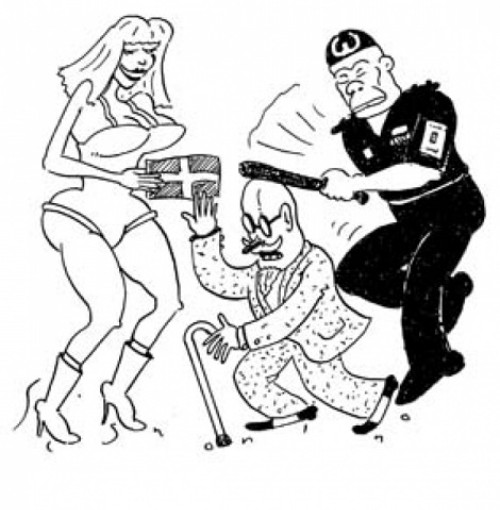Is the woman committing the crime by selling herself or is the man committing the crime by paying for the service? —MEDuke
Who says feminism hasn’t accomplished anything? Nowadays, in most American jurisdictions, both the hooker and the john are committing a crime in the eyes of the law. That may not seem like much of an achievement, but for much of the 20th century, prostitution was something only women could get arrested for in the United States (In fact, some laws were written so narrowly that even male prostitutes were off the hook.) These laws have since been mostly amended or replaced, so that today, while we may not have equal rights, at least we’ve got equal wrongs. One country, Sweden, has gone to the opposite extreme. There, selling your body is legal (the politically correct term is “sex work”), but heaven help the chump who wants to buy.
Though prostitution has never been a high-status occupation, the occasional royal courtesan excepted, for the most part, it wasn’t illegal in this country’s early years—though streetwalkers who made themselves conspicuous did risk being charged with vagrancy, public lewdness, or the like. That changed in the late 19th and early 20th centuries, an era that saw the criminalization of vices (other examples: gambling, some drugs) that till then had been considered matters for the pulpit, not the courts. But whereas narcotics laws penalized both sellers and buyers (to be precise, possessors), prostitution laws typically went after just one party in the transaction. Why? Some legal commentators point to a well-known and persistent double standard: Whereas men were seen as helpless victims of their libidos, women supposedly had no inherent interest in sex and sold themselves out of sheer wickedness.
It took a long time for that standard to change. As of 1917 only one state, Indiana, had specifically declared that patronizing prostitutes was a crime. (A few others technically defined prostitution to include both the purchase and sale of sex, although few male buyers were charged.) By 1965, that number had risen to seven. In the ’70s several states, including New York and Massachusetts, enacted antijohn laws, whose goal was to suppress prostitution by embarrassing customers—in 1979 New York City mayor Ed Koch famously read on the radio the names of men convicted of soliciting hookers. I hesitate to attribute this entirely to some newfound sense of fair-mindedness among public officials; clearly the main goal was more effective enforcement. But at least lawmakers had grasped that the minimum number of participants in a successful act of prostitution was two.
Today antijohn laws are fairly common, but even now, the treatment of prostitution customers is far from uniform. In a few jurisdictions—Kentucky is one of them—state law remains squarely focused on those selling sex, leaving it to the discretion of local authorities to criminalize buying it. Others treat all parties equally. And some punish customers but deal with them more leniently than they do prostitutes, evidently on the same argument used to justify treating drug dealers more harshly than mere users.
As a practical matter, there’s no doubt the legal hammer falls more heavily on women, although arrest figures aren’t as lopsided as they used to be. In 1970, close to 80 percent of those arrested for prostitution and related charges were female, according to FBI statistics; by 1993, that figure had dropped to 59 percent. As of 2006, it had bounced back up to 64 percent but the total number of prostitution/vice arrests for both sexes was down significantly, surely progress of a sort.
The law does come down hard, if sporadically, on one male-dominated aspect of the sex trade: pimping, legally known as pandering. The best-known statute along these lines is the 1910 federal Mann Act, formally called the White-Slave Traffic Act, which, as written, prohibited interstate transportation of women for “prostitution or debauchery, or for any other immoral purpose.” In fact, the Mann Act has often been used to go after plain old johns, albeit famous ones, who allegedly consorted with prostitutes or in some cases simply women other than their wives. As noted in an NPR story in the wake of the Eliot Spitzer scandal, targets of Mann Act prosecution—some would say persecution—include Chuck Berry, Charlie Chaplin, the boxer Jack Johnson and Frank Lloyd Wright. The law has since been amended to specify that the parties involved must be engaged (or planning to engage) in actual crimes, as opposed to some prosecutor’s notion of immorality. Which, again, constitutes progress, I suppose. But we still have a distance yet to travel before reaching what I’d consider the reasonable position on such matters—namely that what consenting adults do, regardless of financial considerations and assuming they don’t blight the neighborhood or disturb the peace when doing it, is really no business of the state.
Comments, questions? Take it up with Cecil on the Straight Dope Message Board, StraightDope.com, or write him at the Chicago Reader, 11 E. Illinois, Chicago 60611.
More by Cecil Adams
-
This Is the End, My Friend
This week's Straight Dope marks the last appearance of the column as the Teeming Millions have known it for the past 45 years.
- Jul 11, 2018
-
Do Brain Supplements Do Anything?
Brain Drain
- Jul 4, 2018
-
Is flying really worse for the environment than driving?
Planes and Trains
- Jun 27, 2018
- More »




